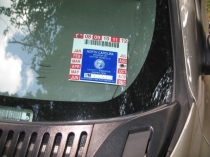 My older boy was playing a game last week in Fairfax County with his high school JV team. This being his first experience with this level of baseball, it’s been quite the education for him. For rather than play in the JV division, his team is playing other varsity teams, meaning big, strong kids with pitchers hurling well north of 80mph.
My older boy was playing a game last week in Fairfax County with his high school JV team. This being his first experience with this level of baseball, it’s been quite the education for him. For rather than play in the JV division, his team is playing other varsity teams, meaning big, strong kids with pitchers hurling well north of 80mph.
Gus has struggled a bit at the plate, as has almost every player, but he’s held his own. And his team was holding a 3-1 lead going into the 7th inning of a well-contested battle. Gus was catching, and our new pitcher was struggling badly. He had already given up a run, had walked four batters, and they had the bases loaded with no one out.
When the count went to 3-2, we awaited the inevitable. Our pitcher went into his stretch, came set, and…
THONK
…the lights went out.
10pm. Nite-nite for this particular field.
The 7th inning ceases to exist, and we win 3-1.
As the gossamer batter threw his shadowy helmet to the ground in frustration, all of us parents looked at each other with a guilty grimace.
“That’s not a good ending for anybody,” said Joe, one of Gus’s former youth travel coaches, whose son is also on the team.
I am reminded of this given the ugly events that happened last night with Chase Utley breaking the leg of Ruben Tejada in the NLDS Game 2 between the Dodgers and my beloved Mets. While the event wounded my not-so-inner Mets fan, it and the reaction to it hurt CoachN more.
Here’s what I posted on Facebook in an open letter to MLB:
Dear MLB.com you, and the umpires you employ, decided to show baseball-loving kids around the country that, so long as you think you can get away with it, it is okay to try and hurt a defenseless player because the play is so important.
I heard the talking heads on MLB Network talk about how catchers are now protected, so why not middle-infielders? THEY ARE PROTECTED! THERE IS A RULE! It just takes the minimal courage involved in simply doing your job.
This is made far worse by the fact that it was Chase Utley, a Hall of Fame-caliber ballplayer with a history of playing dirty. I’m not going to sugarcoat that. Hard-nosed is fine, it is great. But Utley has crossed that line multiple times, and your cringing from the proper course of action is an open encouragement for hyper-competitive players and coaches to think that somehow this is acceptable because, after all, the Dodgers won in the end.
Youth baseball, particularly at the travel level, is plagued by the “Winning is the Only Thing” mentality. It is a significant reason why participation in travel baseball is down across the country, as parents are increasingly wary of putting their children in a system where their values and priorities for their kids, such as fair play, respect for teammates and opponents, and that the competition is as important as the result, are subverted by a concept of the game that prioritizes results over process or even the rules themselves.
Your umpires, and then the subsequent confused, half-hearted, finger-pointing “defense” of what happened by Joe Torre only serves to reinforce this notion.
As a Mets fan, I was okay with losing last night. Not only did we already win one, the Mets have given me a thrilling season win-or lose. What you and your umpires have done by cowering away from upholding the rules damages the game in ways well beyond this game or this series, or even the Major Leagues itself.
As a father, a youth coach, and a fan, I am disgusted by everything that has happened during and after that play. You should be ashamed. I will certainly be addressing this with my players, as hopefully at least someone can learn the right lesson from this event.
With greatly diminished respect,
Scott Nathanson
Manager/Head Coach
CoachN’s FUNdamentals
Utley has now been suspended two games for the illegal slide. As one Twitter poster noted, “I wonder if Tejada can appeal his broken leg?” Of course, Utley has appealed, like a true bully refusing to admit he’s done anything wrong.
For while my son’s victory came with a bit of embarrassment to his team, Utley and the reaction by his Dodger teammates and Major League Baseball has embarrassed the game.


























